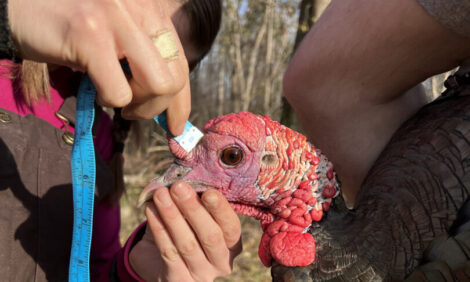



US Poultry Outlook Report - December 2009
Output of chicken meat has been revised downwards, and turkey production is significantly down from last year, according to the USDA Economic Research Service December 2009 Livestock, Dairy and Poultry Outlook.Summary
Continued declines in chick placements has resulted in a reduction in the fourth-quarter 2009 broiler meat production estimate to 8.85 billion pounds and reductions to all the quarterly production estimates in 2010.
Turkey production continues to be down strongly from the previous year. Although prices for whole birds have risen recently, the turkey hatchery numbers indicate that turkey meat production will be lower through the first half of 2010. October cold storage holding estimates for whole turkeys fell to levels below the previous year for the first time in 2010.
The number of hens in the table egg flock was higher than the previous year in October, but egg prices are forecast to be significantly higher in fourth-quarter 2009, compared with the previous quarter.
Broiler Meat Production Falls in October
Broiler meat production totalled 3.06 billion pounds in October, down 6.3 per cent from the previous year. Much of the decline in meat production is due to one slaughter day fewer in October 2009 than the previous year. Over the first 10 months of 2009, broiler meat production has declined steeply, with only March showing a slight increase. The total for period January to October 2009 was 29.7 billion pounds, five per cent lower than in the same period a year earlier. In October, the number of birds slaughtered fell 7.1 per cent from the previous year. This decrease was partially offset by a small increase in the average live weight of birds at slaughter, up 0.4 per cent to 5.67 pounds. With the lower-than-expected production in October and chick placements still below year-earlier levels, the broiler meat production estimate for fourth-quarter 2009 was lowered by 100 million pounds to 8.85 billion. The meat production estimates for all four quarters of 2010 were also reduced, resulting in a new annual total of 35.9 billion pounds, up one per cent from 2009.
The number of chicks being placed weekly for grow-out is now approaching the level of 2008. The difference between the numbers of chicks placed for grow-out in the last several weeks and during the same period the previous year is now averaging less than one per cent. With only a small difference in chick placement, even a small increase in average bird weight at slaughter could translate into a small year-over-year increase in broiler meat production starting in the first quarter of 2010. Over the last five weeks (7 November to 5 December 2009), the number of chicks placed for grow-out averaged 0.4 per cent lower than the same period in 2008. The number of broiler chicks hatched in October 2009 was 728.9 million, down 1.6 per cent from the previous year, but the smallest year-over-year decline since June 2008.
Cold storage holdings of broiler products at the end of third-quarter 2009 were revised slightly to 613 million pounds. This is down 20 million pounds from the end of the second quarter and is 16 per cent lower than third-quarter 2008 ending stocks. Stocks are expected to decline gradually during the fourth quarter as production declines reduce overall supplies. The estimate for fourth-quarter 2009 ending stocks was revised downward to 610 million pounds, 135 million pounds lower (18 per cent) than a year earlier. At the end of October 2009, stock levels were lower for almost all broiler products compared with the previous year. With the downward revision in production, broiler product stock levels were also lowered for all four quarters in 2010. Stock levels are not expected to be significantly higher than those of 2009 until later in 2010.
In fourth-quarter 2009, the broiler industry is expected to have slightly lower production, smaller exports and a strong decline in cold storage stocks compared with the previous year. Normally, lower production and stock levels would gradually put upward pressure on most broiler prices, but adverse economic conditions have offset these factors by lowering overall demand. Fourth-quarter 2009 prices for whole birds are expected to average 71 to 72 cents per pound, down about 10 per cent from a year earlier.
Broiler Exports Fall in October
In October, total broiler exports totalled 624 million pounds, down 4.9 per cent from the previous year, but higher than had been expected. Much of the year-over-year decline was due to lower shipments to countries such as the Ukraine, Angola, Lithuania and the UAE, that were mostly offset by higher shipments to Russia – 192 million pounds, up 29 per cent. Over the first 10 months of 2009, broiler exports have totalled 5.75 billion pounds, down two per cent from the same period in 2008. The largest sources of the decline have been Russia (down 220 million pounds or 13 per cent) and the Ukraine (down 182 million pounds or 53 per cent). Total exports for fourth-quarter 2009 are forecast at 1.6 billion pounds.
October Turkey Production Falls Sharply
Turkey meat production in October totalled 507 million pounds, down 12.8 per cent from October 2008. The decrease was the result of an 11.7 per cent decline in the number of birds slaughtered, partially due to one slaughter day fewer and a 1.5-per cent fall in the average weight of birds at slaughter, to 28.4 pounds. The year-over-year decrease in turkey meat production in October continues the pattern of production declines seen during the first nine months of 2009. To date (January to October), turkey production has totalled 4.7 billion pounds, 9.9 per cent below the same period in 2008.
Even with the lower exports seen to date and adverse economic conditions, the continued year-over-year declines in production have gradually reduced turkey stocks. The data for the end of October showed whole bird stocks at 299 million pounds, down 3.7 per cent from a year earlier. Whole turkey stocks had started 2009 at 194 million pounds, 98 per cent higher than the previous year. Monthly stock levels remained higher than the previous year through September but have now moved below year-earlier levels. Stocks of turkey parts were estimated at 212 million pounds at the end of October, down 21 per cent from a year earlier. With lower turkey production expected in the fourth quarter, total turkey ending stocks for 2009 were reduced to 350 million pounds, 12 per cent less than the previous year. With lower production also expected in 2010, the quarterly cold storage estimates for turkey products are expected to remain below 2009 levels.
After being lower than a year earlier over the first 11 months of 2009, prices for whole hens in the Eastern market are expected to be higher in December as declining whole bird stocks over the last several months have placed upward pressure on prices. With lower production and stock levels now below year-earlier levels, prices for whole turkeys are expected to average 83 to 84 cents per pound in fourth-quarter 2009, still down 4 per cent from the previous year, but significantly higher than expected earlier. Even with this year-end strengthening, the annual price for 2009 is expected to average 79.5 cents per pound, declining nine per cent from 2008 after rising for five consecutive years.
Over the first 10 months of 2009, the number of turkey poults placed for grow-out has totalled 231 million, down eight per cent from the same period in 2008. The size of the year-over-year differences has been declining in recent months but the lower poult placements definitely point toward continued declines in turkey production through at least the first half of 2010.
Turkey Exports Down Sharply
October turkey exports fell by 32 per cent to 49 million pounds, continuing the trend of much smaller turkey exports over the first nine months of 2009. As in previous months, much of the decline is due to smaller shipments to Mexico. In October, shipments to Mexico were only 21 million pounds, down 42 per cent from the previous year. Shipments to Canada, China and Hong Kong were also down significantly. Fourth-quarter 2009 turkey exports are forecast at 145 million pounds, a 20-per-cent decline from the same period in 2008. With the current weakness in the Mexican economy, the 2010 turkey export forecast is for only a two-per-cent increase in shipments to all destinations.
Table Egg Production Continues Higher
The table egg laying flock in October was estimated at 280 million hens, 0.8 per cent above the previous year. Year-over-year table egg flock numbers have been mixed so far in 2009, with the flock size up in six months and lower in three, and one month where the size showed no change. The table egg flock is expected to remain higher than the previous year through the remainder of 2009 although only by a small amount. At the beginning of November, the estimate of the table egg flock was up but by less than one per cent. The number of birds in the table egg flock is expected to expand slightly in 2010 in response to gradually increasing wholesale egg prices in the second half of 2009 but incentives to expand production will be tempered by concerns about the impacts of continued high unemployment rates and economic uncertainties on demand.
Table egg production has been higher than the previous year in nine of the first 10 months of 2009. In October, production was 553 million dozen, an increase of 1.5 per cent from the previous year. Even with the higher production, table egg prices have been increasing recently. The fourth-quarter 2009 wholesale price in the New York market is forecast at between $1.16 and $1.19 per dozen, up considerably from earlier estimates as November and early December prices rapidly moved higher. Based on the strong prices in December, the price estimates for the first and second quarters of 2010 were also increased.
Egg Exports Higher
Unlike broiler and turkey meat, exports of eggs and egg products have been higher so far in 2009. In October, shipments were the equivalent of 26.8 million dozen eggs, up 49 per cent from October 2008. October exports were higher to Canada, Hong Kong and even Japan. Shipments to Japan had been down sharply over the first nine months of 2009. However, the largest increase was in shipments to Germany, up 369 per cent to four million dozen. Over the first 10 months of 2009, exports of eggs and egg products have been the equivalent of 196 million dozen eggs, 12 per cent higher than the same period in 2008. Much of the increase has come from sharply larger shipments to Canada and Hong Kong, two of the top US export markets.
Further Reading
| - | You can view the full report by clicking here. |
December 2009








